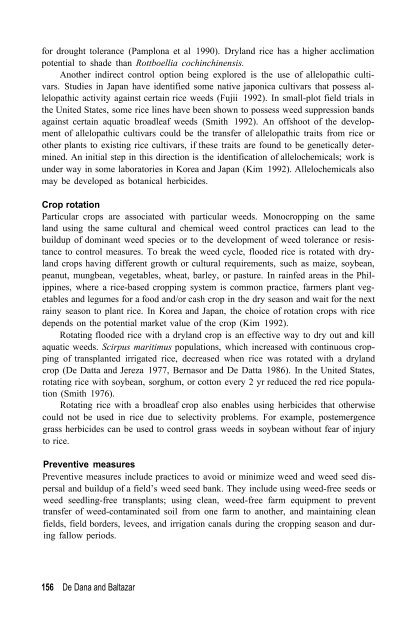HERBICIDES in Asian rice - IRRI books - International Rice ...
HERBICIDES in Asian rice - IRRI books - International Rice ...
HERBICIDES in Asian rice - IRRI books - International Rice ...
Create successful ePaper yourself
Turn your PDF publications into a flip-book with our unique Google optimized e-Paper software.
for drought tolerance (Pamplona et al 1990). Dryland <strong>rice</strong> has a higher acclimation<br />
potential to shade than Rottboellia coch<strong>in</strong>ch<strong>in</strong>ensis.<br />
Another <strong>in</strong>direct control option be<strong>in</strong>g explored is the use of allelopathic cultivars.<br />
Studies <strong>in</strong> Japan have identified some native japonica cultivars that possess allelopathic<br />
activity aga<strong>in</strong>st certa<strong>in</strong> <strong>rice</strong> weeds (Fujii 1992). In small-plot field trials <strong>in</strong><br />
the United States, some <strong>rice</strong> l<strong>in</strong>es have been shown to possess weed suppression bands<br />
aga<strong>in</strong>st certa<strong>in</strong> aquatic broadleaf weeds (Smith 1992). An offshoot of the development<br />
of allelopathic cultivars could be the transfer of allelopathic traits from <strong>rice</strong> or<br />
other plants to exist<strong>in</strong>g <strong>rice</strong> cultivars, if these traits are found to be genetically determ<strong>in</strong>ed.<br />
An <strong>in</strong>itial step <strong>in</strong> this direction is the identification of allelochemicals; work is<br />
under way <strong>in</strong> some laboratories <strong>in</strong> Korea and Japan (Kim 1992). Allelochemicals also<br />
may be developed as botanical herbicides.<br />
Crop rotation<br />
Particular crops are associated with particular weeds. Monocropp<strong>in</strong>g on the same<br />
land us<strong>in</strong>g the same cultural and chemical weed control practices can lead to the<br />
buildup of dom<strong>in</strong>ant weed species or to the development of weed tolerance or resistance<br />
to control measures. To break the weed cycle, flooded <strong>rice</strong> is rotated with dryland<br />
crops hav<strong>in</strong>g different growth or cultural requirements, such as maize, soybean,<br />
peanut, mungbean, vegetables, wheat, barley, or pasture. In ra<strong>in</strong>fed areas <strong>in</strong> the Philipp<strong>in</strong>es,<br />
where a <strong>rice</strong>-based cropp<strong>in</strong>g system is common practice, farmers plant vegetables<br />
and legumes for a food and/or cash crop <strong>in</strong> the dry season and wait for the next<br />
ra<strong>in</strong>y season to plant <strong>rice</strong>. In Korea and Japan, the choice of rotation crops with <strong>rice</strong><br />
depends on the potential market value of the crop (Kim 1992).<br />
Rotat<strong>in</strong>g flooded <strong>rice</strong> with a dryland crop is an effective way to dry out and kill<br />
aquatic weeds. Scirpus maritimus populations, which <strong>in</strong>creased with cont<strong>in</strong>uous cropp<strong>in</strong>g<br />
of transplanted irrigated <strong>rice</strong>, decreased when <strong>rice</strong> was rotated with a dryland<br />
crop (De Datta and Jereza 1977, Bernasor and De Datta 1986). In the United States,<br />
rotat<strong>in</strong>g <strong>rice</strong> with soybean, sorghum, or cotton every 2 yr reduced the red <strong>rice</strong> population<br />
(Smith 1976).<br />
Rotat<strong>in</strong>g <strong>rice</strong> with a broadleaf crop also enables us<strong>in</strong>g herbicides that otherwise<br />
could not be used <strong>in</strong> <strong>rice</strong> due to selectivity problems. For example, postemergence<br />
grass herbicides can be used to control grass weeds <strong>in</strong> soybean without fear of <strong>in</strong>jury<br />
to <strong>rice</strong>.<br />
Preventive measures<br />
Preventive measures <strong>in</strong>clude practices to avoid or m<strong>in</strong>imize weed and weed seed dispersal<br />
and buildup of a field’s weed seed bank. They <strong>in</strong>clude us<strong>in</strong>g weed-free seeds or<br />
weed seedl<strong>in</strong>g-free transplants; us<strong>in</strong>g clean, weed-free farm equipment to prevent<br />
transfer of weed-contam<strong>in</strong>ated soil from one farm to another, and ma<strong>in</strong>ta<strong>in</strong><strong>in</strong>g clean<br />
fields, field borders, levees, and irrigation canals dur<strong>in</strong>g the cropp<strong>in</strong>g season and dur<strong>in</strong>g<br />
fallow periods.<br />
156 De Dana and Baltazar

















